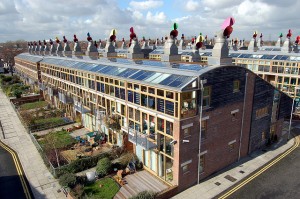
A new report published by WWF UK finds that 60% to 90% of the UK’s electricity could come from renewable energy sources such as wind, tidal, and solar energy by 2030.
“By using this amount of renewable energy, we can decarbonise the power sector without resorting to new nuclear power. We will also be able to maintain system security – that is, provide enough electricity at all times to make sure there’s never a risk of the ‘lights going out’,” the report states.
Like the US, the UK has many “aging” power plants that will soon be decommissioned. These power plants produce about 25% of the UK’s electricity. With a directive from the Climate Change Act to be carbon-free by 2030, this poses a challenge but also a great opportunity to lead the world in renewable energy.
Here’s more from WWF UK’s executive summary on the new report:
We commissioned GL Garrad Hassan (GL GH) to investigate this question by developing six scenarios for where the UK’s electricity will come from in 2030. The scenarios all achieve the near decarbonisation of the power sector by 2030 without new nuclear power. The generation mix differs according to the level of electricity demand and the use of different methods for ensuring system security as shown in the table opposite.
In all cases, the scenarios make full provision for ambitious increases in electric vehicles (EVs) and electric heating. Energy efficiency and behavioural change lead to the reductions in demand in the ambitious demand scenarios.
The volume of renewable capacity installed by 2020 in all scenarios is similar to that set out in the government’s Renewable Energy Roadmap in July 2011. However, critically, the scenarios envisage installation continuing at a similar rate during the 2020s. This will avoid the risk of ‘boom and bust’ in the UK renewables sector – lots of work being done to install renewable capacity up until 2020 and then work falling off a cliff after that – and mean renewables provide at least 60% of the UK’s electricity by 2030.
The amount of renewable capacity the UK can and should build is determined by economic constraints – not available resources or how fast infrastructure can be built. GL GH assumes that it is economic to supply around 60% of demand from renewables. Going beyond 60% depends on whether there’s a market in other countries for the excess electricity the UK would generate at times of high renewable energy production. Therefore, given uncertainty over future markets, in the core scenarios (A and B) GL GH has not assumed a European market for UK renewable power despite the construction of high levels of interconnection under the B scenarios. By contrast, in the stretch scenarios (C), we assume that interconnection creates a European market for the UK’s excess power, and that it becomes economic to build much more renewable capacity in the UK.
Source: cleantechnica

 Follow
Follow